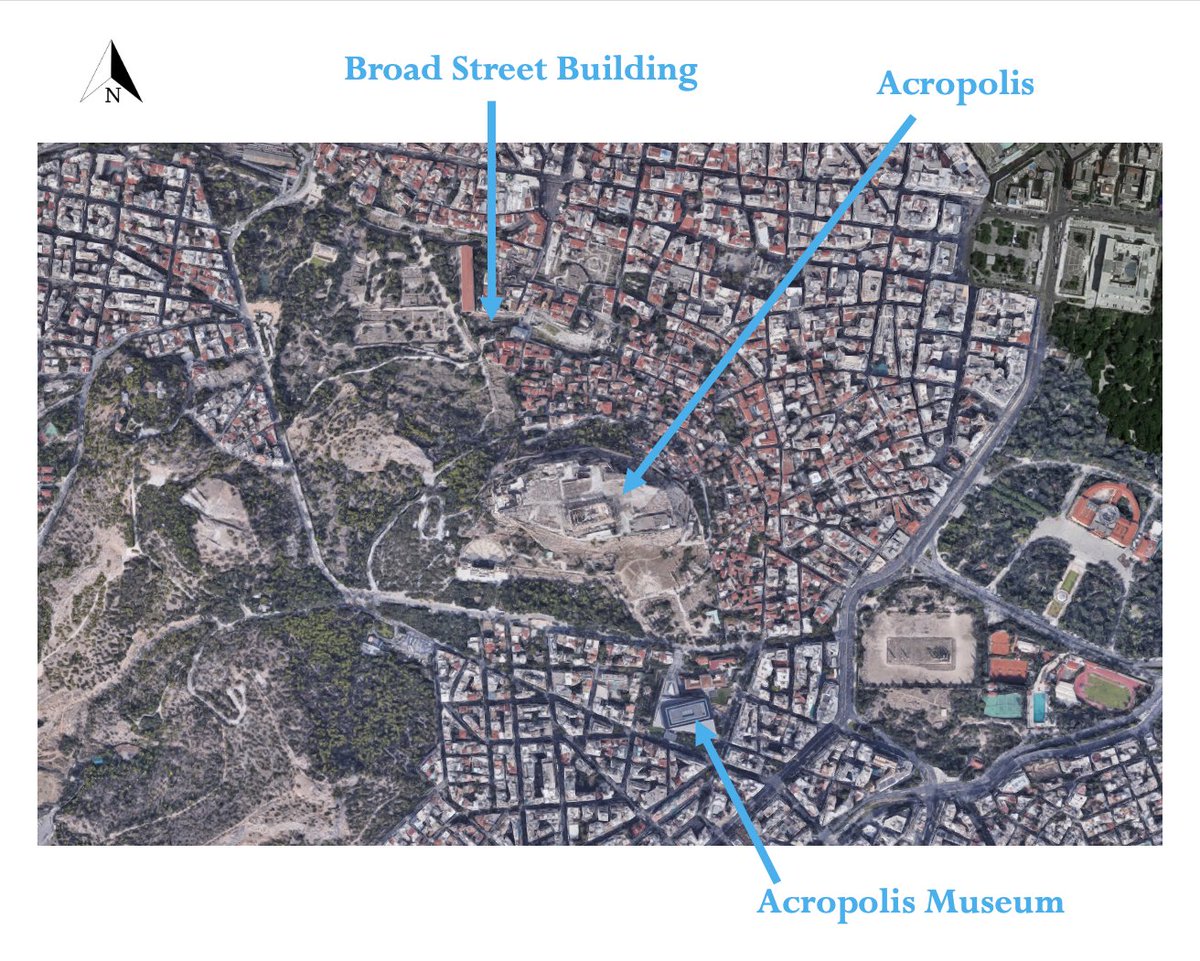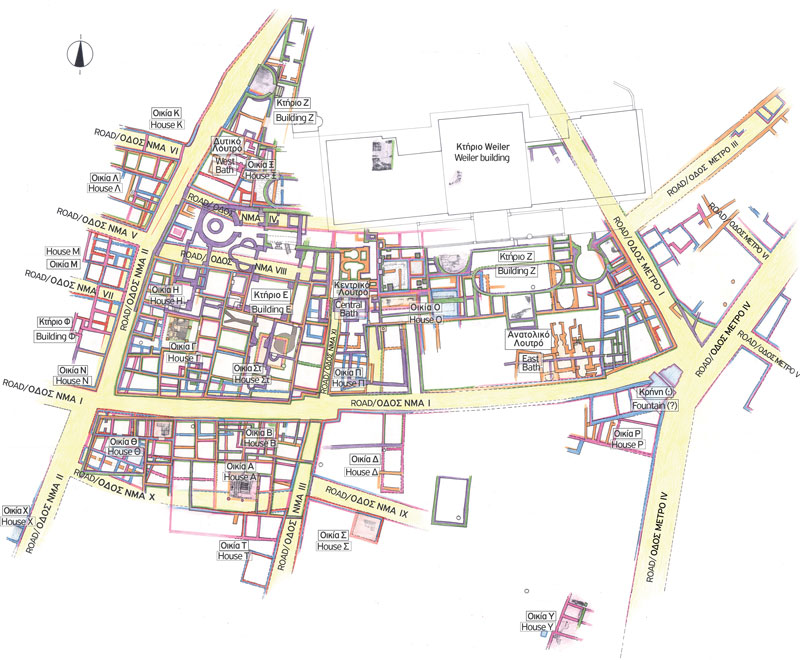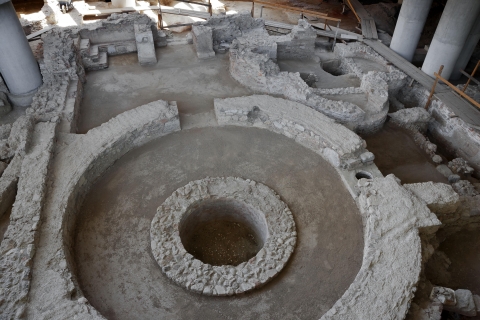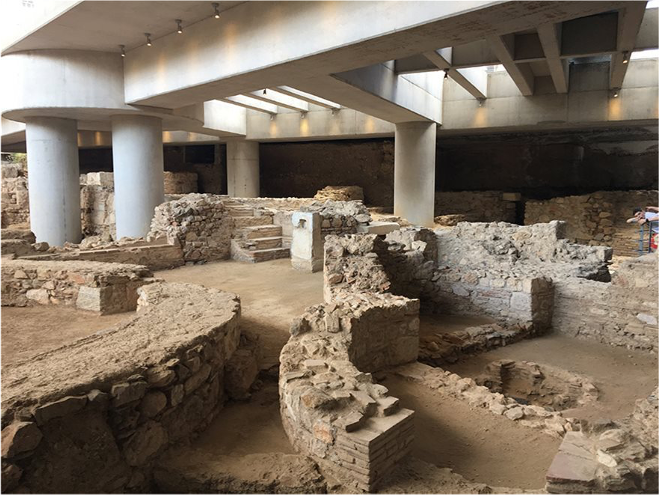This is the excavation site under the #AcropolisMuseum in #Athens. While the museum displays the Classical era - the period most traditionally associated w/ Athens - the excavation below showcases #7thCenturyAthens, representing a new direction in Athenian archaeology. A thread!
Before I begin, if you missed yesterday's thread on the visit of Constans II to Athens in 662-3, check it out here: https://twitter.com/Tweetistorian/status/1355735000864358400?s=20
The Acropolis Museum is located south of the Acropolis. This is immediately significant. The Late Antique city was traditionally believed to only be within the city walls north of the Acropolis. The remains under the museum indicate that the city was larger & more spread-out.
In Late Antiquity, around the fifth century C.E., the area was mainly a residential district. Courtyard houses of varying sizes coexisted side-by-side, demonstrating a neighborhood of mixed-wealth inhabitants. The largest and most opulent of these houses was Building Z.
Constructed over two older mansions, it featured a private bath and decorative mosaic floors, both elements also seen in the Omega House (see past thread). The archaeologists who excavated Building Z theorize this may have been the house of a local civic official.
The house underwent multiple renovations across the fifth and sixth centuries. In the late sixth or early seventh century, Building Z was significantly remodeled, with a completely new, two-story wing added. This wing is known as Building E.
Building E featured a large reception hall w/ an apse. Next to this room was a triclinium, used by Building E's owner & friends for dinner gatherings. To the north sits a large circular structure resembling a tower. Around this were multiple smaller storerooms.
These are significant features, supportive of a capable, dynamic population. If Building Z was a domestic mansion like the Omega House, Building E may have been an administrative hub like the Broad Street Building, evidenced by the apsidal reception hall.
A room of this type generally indicates that the owner of the building was expecting to receive guests, likely for business purposes. However, we also see evidence of a triclinium, indicating that there may have been a space for entertaining or gathering socially.
This was a building for socializing and strategizing, indicating a sense of community in seventh-century Athens. This social component again speaks to the vitality of the city. Physicality is not the only thing which makes a city; it is also formed by community.
We also see numerous workshops in this vicinity, indicating a certain level of industry in the city. For more, see: https://www.theacropolismuseum.gr/en/buildings/early-byzantine-workshops
These remains are significant for dismantling the myth of "Dark Age" Athens. In June 2019, the Acropolis Museum opened the archaeological site to the public, incorporating it into the museum's permanent exhibition.
The Late Antique remains are an integral part of this public site. Building E's distinctive round tower base is impossible to miss, and its design is prominently featured in gift shop souvenirs - a rare, if not unprecedented, feat for a 7th-c. Athenian ruin.
For centuries, archaeologists in Athens have ripped through Late Antique & Byz. layers to reach their priority, the Classical era. But here, 7th-c. remains are not only left in situ but are on full display. They are not disregarded in Athens' urban history but are fully embraced.
In my next (and last!) thread, I will conclude our week on 7th-century Athens and pass the baton to our next Tweeting Historian. Thanks for a great week! -ag ( @Allison_Grenda)
(Note: the museum's website says Building E was built in the early 6th c., not 7th. This is curious because the excavation reports date it to the late 6th/early 7th. They also note finding coins from Heraclius (r. 610-641) & Constans II. I hope further publications will clarify.)
Bibliography:
Stamatia Eleutheratou and Nikoletta Saraga, Οικόπεδο Μακρυγιάννη, Ανασκαφές γιά τήν ανέγερση τοû Νέου Μουσείου Ακροπολεως, ArchDelt 54 (1999) B'.
The Acropolis Museum recently redid its website, with spectacular photos and information: https://theacropolismuseum.gr/en/exhibit-halls/archaeological-excavation
Stamatia Eleutheratou and Nikoletta Saraga, Οικόπεδο Μακρυγιάννη, Ανασκαφές γιά τήν ανέγερση τοû Νέου Μουσείου Ακροπολεως, ArchDelt 54 (1999) B'.
The Acropolis Museum recently redid its website, with spectacular photos and information: https://theacropolismuseum.gr/en/exhibit-halls/archaeological-excavation
An old observation of a photo used in this thread https://twitter.com/Allison_Grenda/status/1259285056863866881?s=20
A whole thread on the issue of dating Building E: https://twitter.com/Allison_Grenda/status/1251318210781044737?s=20
@FlintDibble also has a magnificent thread on the Acropolis Museum and its archaeological site: https://twitter.com/FlintDibble/status/1189145182954033152?s=20

 Read on Twitter
Read on Twitter











